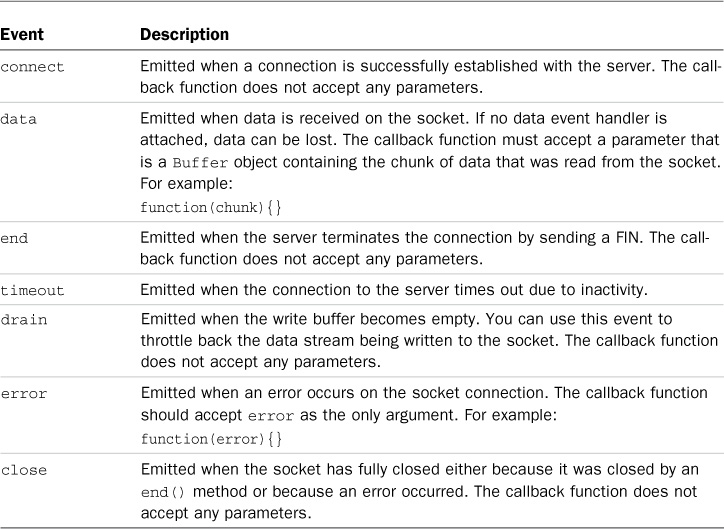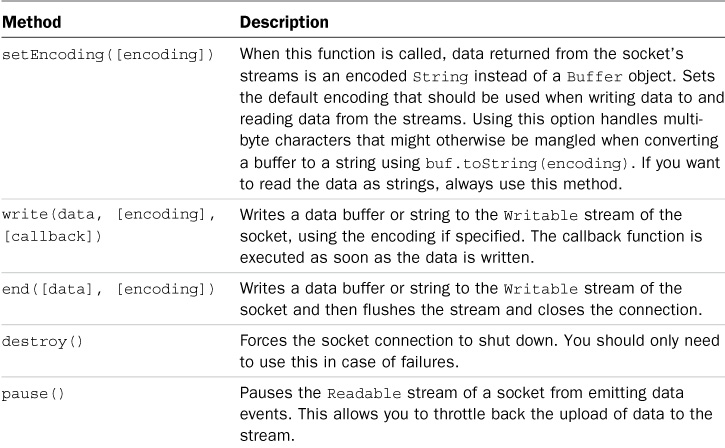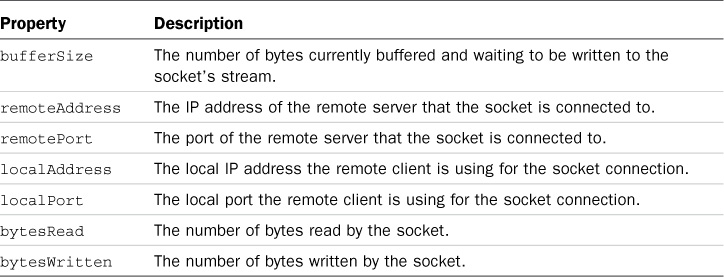The net.Socket Object
Socket objects are created on both the socket server and the socket client and allow data to be written and read back and forth between them. The Socket object implements the Duplex stream, so it provides all the functionality that Writable and Readable streams provide. For example, you can use the write() method to stream writes of data to the server or client and a data event handler to stream data from the server or client.
On the socket client, the Socket object is created internally when you call net.connect() or net.createConnection(). This object is intended to represent the socket connection to the server. You use the Socket object to monitor the connection, send data to the server, and handle the response from the server. There is no explicit client object in the Node.js net module because the Socket object acts as the full client, allowing you to send/receive data and terminate the connection.
On the socket server, the Socket object is created when a client connects to the server and is passed to the connection event handler. This object is intended to represent the socket connection to the client. On the server, you use the Socket object to monitor the client connection as well as send and receive data to and from the client.
To create a Socket object, you use one of the following methods:
net.connect(options, [connectionListener])
net.createConnection(options, [connectionListener])
net.connect(port, [host], [connectListener])
net.createConnection(port, [host], [connectListener])
net.connect(path, [connectListener])
net.createConnection(path, [connectListener])
All the calls will return a Socket object; the only difference is the first parameters they accept. The final parameter for all of them is a callback function that is executed when a connection is opened to the server. Notice that for each method, there is a net.connect() form and a net.createConnection() form. These work exactly the same way.
The first way to create a Socket object is to pass an options parameter, which is an object that contains properties that define the socket connection. Table 8.1 lists the properties that can be specified when creating the Socket object. The second method accepts port and host values, described in Table 8.1, as direct parameters. The third option accepts a path parameter that specifies a file system location that is a Unix socket to use when creating the Socket object.
Once the Socket object is created, it provides several events that are emitted during the life cycle of the connection to the server. For example, the connect event is triggered when the socket connects, the data event is emitted when there is data in the Readable stream ready to be read, and the close event is emitted when the connection to the server is closed. As you implement your socket server, you can register callbacks to be executed when these events are emitted to handle opening and closing the socket, reading and writing data, etc. Table 8.2 lists the events that can be triggered on Socket objects.
The Socket object also includes several methods that allow you to do things like read from and write to the socket as well as pause or end data flow. Many of these are inherited from the Duplex stream objects, so they should be familiar to you (see Chapter 5, “Handling Data I/O in Node.js”). Table 8.3 lists the methods available on Socket objects.
Socket objects also provide several properties that you can access to get information about the object—for example, the address and port the socket is communicating on, the amount of data being written, and the buffer size. Table 8.4 lists the properties available on Socket objects.
To illustrate flowing data across a Socket object, the following code shows the basics of implementing the Socket object on a client:
var net = require('net'),
var client = net.connect({port: 8107, host:'localhost'}, function() {
console.log('Client connected'),
client.write('Some Data
'),
});
client.on('data', function(data) {
console.log(data.toString());
client.end();
});
client.on('end', function() {
console.log('Client disconnected'),
});
Notice that the net.connect() method is called using an optional object containing a port and host attribute. The connect callback function logs a message and then writes some data out to the server. To handle data coming back from the server, the on.data() event handler is implemented. To handle the closure of the socket, the on('end') event handler is implemented.





